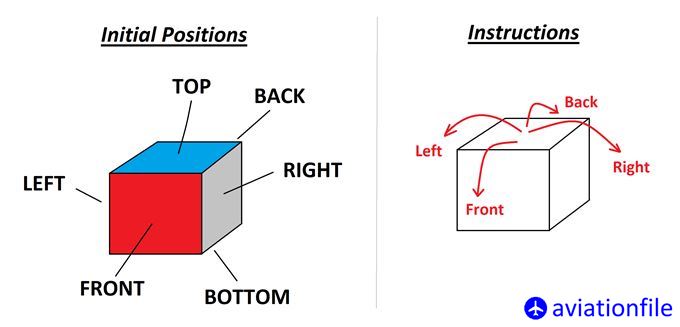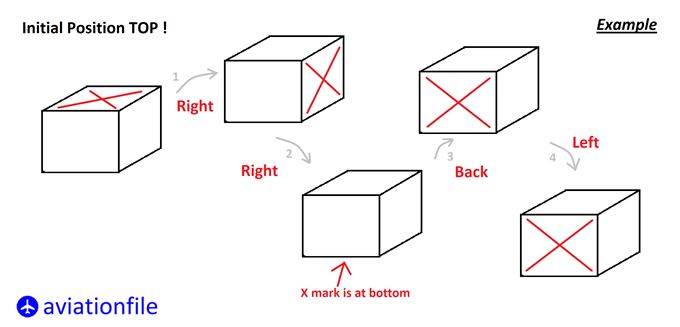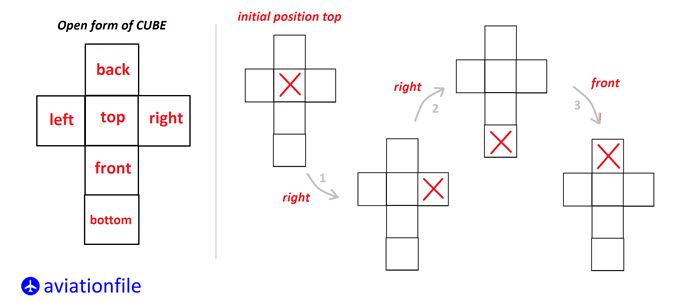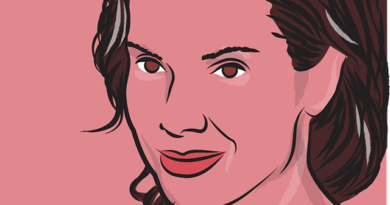DLR – Cube Rotation
In this article we are going to cover the cube rotation section of DLR test with details. You will find structure of cube rotation, examples and some techniques that may help to examiners.
As aviationfile, we recommend our sister platform testaviation.com for preparation for exams such as FEAST and DLR. You can solve sample exams and find more information on the subject by visiting testaviation.com.
Before we start let’s define that the DLR is an institution that Germany has commissioned for aerospace exploration. Meaning the German Aerospace Center (German: Deutsches Zentrum für Luft- und Raumfahrt e.V.), acronym and commonly known as “DLR”.
Let’s start with structure. On this test you will listen a voice from recording. This voice firstly gives the beginning position of the cube by saying one of “top”, “bottom”, “back”, “front”, “left” and “right” positions. This position is the starting point of your mark (you may mark that position on your mind with a dot, cross or star or anything you wish. In the exam there will be cross as mark (you will see the visualization at the image). As you deduce from its name “cube rotation” you will deal with that cube, and there will be some instructions of rotation directions to the cube (instructions: “left”, “right”, “front”, “back”). You will hear these instructions in sequence without a break. There are random number of instructions (generally not more than 15) and when the voice stops you are expected to specify the final position of the mark among answers.

Here is an example…

Please analyze the example more than once and try to deduce some tips for yourself. In the final step (step four), you see that when the mark is at the front position and the instruction is left, position of mark remains front. Similarly, it is easy to think that when the position is front and the instruction is right then no changeor when the position is back and the instruction is right or left then no change again. Moreover, same logic for positions left and right. when the position left or right and the instruction is back or front than there will be no change on the marks position.
Now here there is another deduction. When the arbitrary instructions are “right left” or “left right” or “front back” or “back front” there will be no change again because they are opposite directions and neutralize each other.
As you see there are some tips and techniques that may help you on Cube Rotation. By training I am sure that you will find more tips and techniques and you will use some of them which are more suitable for you. By the way there are some good techniques that may help you from the experiences of other candidates. Come on, let’s have a look to them.
Take a cube toy on your hand
This advice is especially for the beginners and it is believed that it eases your rookie period. Take a toy cube and decide an initial position (you can mark by a pen or decide a surface of the cube) then give self-instructions and follow the marks movement. Good for first steps.
Close your eyes and imagine the cube on your hand
Yes, this is one of the popular methods for test preparation. It is similar to the technique above but this method is one step advanced. Like all methods the essential point is: Do not miss the instructions. Turn the imaginary cube simultaneously on your mind. Also some test takers believe that thinking the position of the mark after each instruction slows the test taker down. If the cube and mark is perfectly on your mind just follow the instructions and in the end you will see the mark’s position. I believe that on the way you will find your perfect technique.
Open Cube Method
This method is quite different from all above. Some test takers believe that this method is very helpful and the best technique while others find it waste of time. Again you will find your own way. Let’s go deeper.

As you see above open cube method works like that. There are some points about this method that need to be explained.
Let’s go with the example, initial position is TOP and the first instruction is RIGHT then mark moves to right. After that the instruction is again RIGHT but there is nowhere for the mark, now close your eyes, close the cube and move the cube to RIGHT, mark goes to bottom. And for the third instruction, mark is at the bottom and instruction is FRONT then mark moves to back.
It is easy to deduce that when mark is on the RIGHT and instruction is RIGHT. Mark is on the LEFT and instruction is LEFT, then mark moves to BOTTOM.
Similarly; when mark is on the BACK and instruction is BACK mark moves to BOTTOM.
You will find many more tips on your way and these are just some examples. Before the final word I want to pinpoint that keep in mind that on some positions with some instructions the position of the mark remains constant. For example: position RIGHT and the instruction is FRONT or BACK, mark is still at the RIGHT position.
Finally, cube rotation is a part of DLR selection tests. By practicing with proper methods it is easy to reach your maximum. Good luck and don’t forget that practice makes better.
For a brief look to all DLR exam click.



thank you so much. May Almighty God bless you